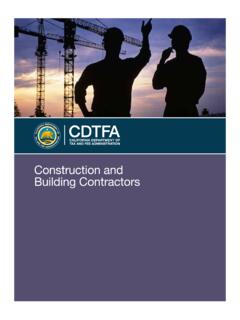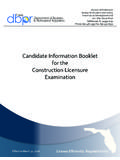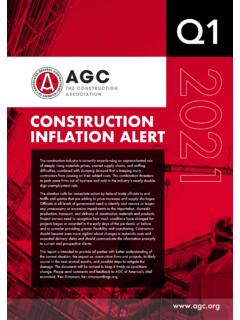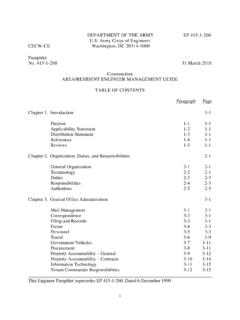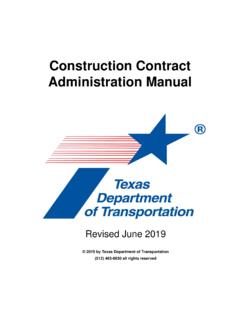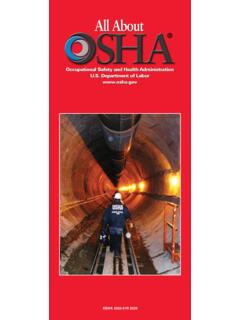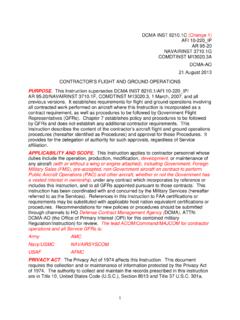Transcription of CONSTRUCTION CONTRACT ADMINISTRATION …
1 CONSTRUCTION CONTRACT ADMINISTRATION February 2019 CONSTRUCTION CONTRACT ADMINISTRATION PRINCIPLES: GUIDE TO CONSTRUCTION CONTRACT PROFESSIONALS JOHN McMULLAN February 2019 Contributors: John McMullan BEng(Civil), LLB, LLM, FIEAust, FIArbA Tracey McMullan BA, LLB Level 4, 111 Coventry Street South Melbourne Vic Australia 3205 Tel: 61 1300 126400 Fax: 61 3 9909 7649 Email: CONSTRUCTION CONTRACT ADMINISTRATION February 2019 INDEX Page 1 Pre- CONTRACT Preparation 1 Standard Form general Conditions 1 Types of CONTRACT 2 Fixed Price/Cost plus 6 Tenders/Probity Principles in Tendering 8 Pre- CONTRACT Discussions/ Misleading and Deceptive Conduct 11 Alliance Contracts 14 Build Own Operate Transfer Projects (PPP)
2 18 Ministerial Directions 1 July 2018 22 2 Design/Construct/Operate Contracts 25 Design Brief 25 Choice of Design & Construct 25 Design Risk under the CONTRACT 27 Design Build Operate 32 3 The Superintendent 38 Dual Role of the Superintendent 38 Functions of the Superintendent 41 Liability of the Superintendent 44 4 Time 46 Practical Completion 46 Extension of Time 47 Liquidated Damages 53 Delay Costs 56 Program 57 Time Bars 58 5 Payment 62 Progress Claim/ Certificate/ Payment 62 Security 65 Valuation of Progress Claims 67 Variations 71 Latent Conditions 74 6 Quality 77 CONTRACT Requirements 77 Defects 79 Quality Assurance 81 Defects Liability Period 82 7 Insurance 85 Care and Control of the Works 85 Types of CONSTRUCTION Insurance 88 Insurance: Principal or Contractor?
3 90 8 Security 95 Cash Retention/Bank Guarantee 95 Security to Remedy/Rectify 97 Conversion of Security to Cash 97 9 Default/Termination 101 Default by the Contractor 101 Default by the Principal 103 Remedies 104 10 Claims 108 CONSTRUCTION CONTRACT ADMINISTRATION February 2019 2 Types of Claims 108 Quantification of Claims 110 Restitution claims claim for a reasonable sum 112 11 Building and CONSTRUCTION Industry Security of Payment Act 2002 (Vic) 116 The Legislative Scheme 116 Payment Claim/Payment Schedule 117 The Adjudication Process 119 Excluded Amounts under the Victorian Act 123 12 Expert determination 128 CONSTRUCTION CONTRACT ADMINISTRATION February 2019 1. PRE- CONTRACT PREPARATION STANDARD FORM CONTRACTS There are many standard form general Conditions of CONTRACT available for use on CONSTRUCTION projects in Australia.
4 AS2124-1992 and AS4000-1997 are currently the most widely-used Standards Australia produced general Conditions of CONTRACT for CONSTRUCTION projects. This standard form was first published in 1952 (originally known as CA24). Since that time it has been reproduced in several editions, changing its designation in 1978 to AS2124. AS2124 was revised in 1978, 1981, 1986 and 1992, then changing, in 1997, to the AS4000-1997 series of general Conditions of CONTRACT . The AS2124-1992 general Conditions of CONTRACT is still widely used (even though the standard form is 25 years old, and was superseded by AS4000-1997 in 1997). AS2124-1992 is the basis of several hybrid general Conditions of CONTRACT , in particular: AS2124-1992 CONSTRUCTION Works AS2545-1987 Sub- CONTRACT AS2987-1987 Equipment Supply and Installation AS3556-1987 Supply AS4300-1995 Design & Construct AS4305-1996 Minor Works There are, however, a number of unfortunate drafting errors in the AS2124-1992 general Conditions of CONTRACT , attributable no doubt to the committee process of revision, which would need to be remedied before the document is suitable for use on major engineering projects.
5 In brief, those drafting flaws include: 1. the document, in its treatment of Bills of Quantities, places the risk of pricing the works with the Principal rather than the Contractor (contrary to the recommendations contained in "No Dispute" which recommended the reverse); 2. uncertain risk allocation in a number of important areas ( default of selected Sub-contractors); 3. inadequate security/retention provisions, which disentitle the Principal from access to security or retention in the event of defective work removing the commercial equivalence of bank guarantees to cash; 4. no provision of collateral contracts within the document (perhaps this is a reflection of the failure of the committee to follow the commercial trends); 5. complex logical difficulties relating to the conflicting roles of the Superintendent (as between his role as agent for the Principal and as an independent certifier); 6.
6 The document does not include an acceleration clause; 7. the latent conditions clause is expressed as a subjective test likely to favour inexperienced Contractors; 8. the extension of time clause has a number of logical and commercial difficulties; 9. the certificate of progress payments by the Superintendent requires the Superintendent to certify for claims, which may involve a legal judgment, and for claims, which may arise out of his own error, which are likely to result in challenges to the certificate by the Contractor; 10. the dispute resolution clause does not constitute a binding arbitration agreement. Many of these (but not all) drafting flaws did not appear in the AS4000-1997 series. That series, however, includes other potential drafting issues (for example, AS4000-1997 does not include a time bar, unlikely to be preferred by principals in selecting a form of CONTRACT ).
7 CONSTRUCTION CONTRACT ADMINISTRATION February 2019 2 AS4000-1997 is the current version of the Standards Australia general Conditions of CONTRACT for CONSTRUCTION . AS4000-1997 (theoretically) superseded AS2124-1992 as the Standards Australia produced general Conditions of CONTRACT for CONSTRUCTION projects. AS4000-1997 (like its predecessor) is the basis of further hybrid general Conditions of CONTRACT , in particular: AS4000-1997 CONSTRUCTION Works AS 4901-1998, Subcontract conditions AS4902-2000 Design & Construct AS4903-2000 Subcontract conditions for design and construct AS4904-2009 Consultants agreement Design and construct AS4905-1996 Minor Works (Principal administered) AS4906-1996 Minor Works (Supt administered) AS4910-2002 Supply of equipment with installation AS/4911:2003 Supply of equipment without installation AS4912-2002 Periodic supply of goods AS4915-2002 Project management general conditions AS4916-2002 CONSTRUCTION management general conditions AS4917-2003 CONSTRUCTION management trade CONTRACT general conditions AS4919-2003 Asset maintenance and services (Superintendent s version) AS4920-2003 Asset maintenance and services (Principal s version) AS4921-2003 Provision of asset maintenance and services (Short version) For the reasons set out above, the AS2124-1992 and AS4000-1997 series of general Conditions of CONTRACT are always substantially amended by private sector principals prior to use on major projects, or not used at all.
8 There are multiple, alternative, standard form CONSTRUCTION contracts in use in Australia. For convenience, and reflecting that the Standards Australia forms of general Conditions of CONTRACT are the most widely used in practice, these notes refer to those standard forms throughout. TYPES OF CONTRACT There are a range of CONTRACT types which may be attractive on a particular project. The choice of a particular style of project delivery system will depend on many factors, for example: ease of design (buildings vs complex engineering projects); desire for design flexibility during CONSTRUCTION ; availability of suitable contractors/project managers, and balance sheets of such contractors; political considerations; budget constraints vs performance of completed project. On major public sector projects, the use of standard form fixed-price contracts would be more prevalent than on similar scale private sector projects (though, in contrast, BOOT projects are essentially public sector projects delivered by the private sector, see below).
9 There are multiple different types of project delivery systems as follows: 1. Fixed Price Contracts The traditional form of CONSTRUCTION CONTRACT has been a fixed price CONTRACT . CONSTRUCTION CONTRACT ADMINISTRATION February 2019 3 The general operation of this type of CONTRACT requires the Contractor to tender on, and then take the risk in relation to, the price of the works. The Contractor, irrespective of the actual cost of the works, will be entitled to be paid no more than and no less than the CONTRACT Sum, as agreed between the parties prior to commencing the works. In fact, for a number of reasons which are discussed elsewhere in this and related topics, a fixed price CONTRACT is rarely performed for exactly the amount of the originally agreed CONTRACT Sum. For example, if the Principal delays the Contractor in obtaining the site, the CONTRACT would usually provide for an increase in the CONTRACT Sum.
10 The critical characteristic, however, of a fixed price CONTRACT , is that the Contractor takes the risk as to the ultimate price, and that the parties agree to pay the CONTRACT Sum (as adjusted pursuant to the provisions of the CONTRACT ). 2. Cost Plus The critical characteristic of the cost plus CONTRACT is that there is no risk, as to cost, borne by the Contractor. The Contractor and the Principal agree, at the time entering into the CONTRACT , that the Contractor will perform the works, and that the Principal will pay for those works, on the basis of the actual cost of the Works to the Contractor, plus an agreed fee, usually an agreed percentage of that sum (or some other agreed incentive over and above the actual cost of the works). A cost plus CONTRACT is, therefore, risk-free, as to cost, for the Contractor.
